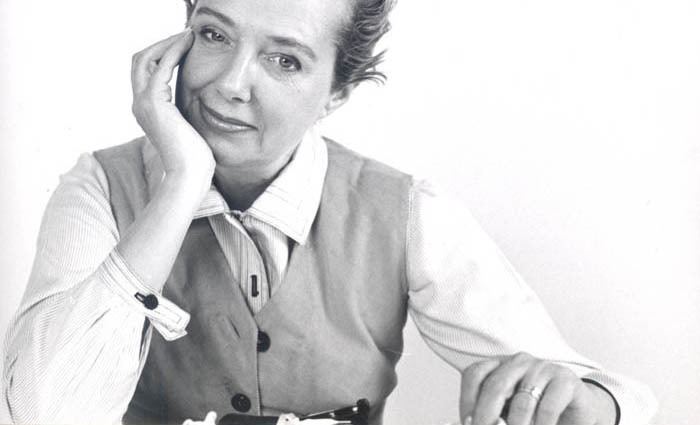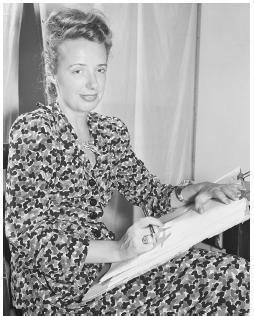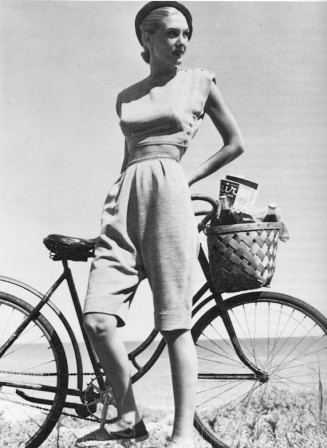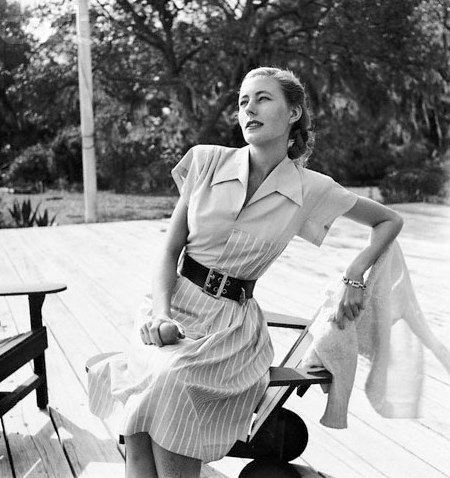Name Claire McCardell | ||
 | ||
Died March 22, 1958, New York City, New York, United States Books What Shall I Wear?: The What, Where, When, and how Much of Fashion Education Hood College, Parsons School of Design Similar Madeleine Vionnet, Zandra Rhodes, Bernard Rudofsky | ||
Claire mccardell 0001
Claire McCardell (May 24, 1905 – 1958) was an American fashion designer in the arena of ready-to-wear clothing in the 20th century. She is credited with the creation of American sportswear.
Contents
- Claire mccardell 0001
- Claire mccardell
- Early life
- 1930s and 1940s
- 1950s
- Personal life and death
- Legacy and influence
- Characteristics of McCardells work
- References

Claire mccardell
Early life

McCardell was the eldest of four children born to Eleanor and Adrian McCardell in Frederick, Maryland. Adrian was a Maryland state senator and president of the Frederick County National Bank. As a child, McCardell earned the nickname "Kick" for her ability to keep the boys from pushing her around.

Fascinated by fashion from a young age, McCardell wanted to move to New York City to study fashion design at age 16. Unwilling to send a teenager so far away, McCardell's father convinced to enroll in the home economics program at Hood College instead. After two years of study in Maryland, McCardell moved to New York and enrolled in Parsons (then known as the New York School of Fine and Applied Art). In 1927, McCardell went to Paris, continuing her studies at the Parsons branch school at the Place des Vosges. In Paris, McCardell and her classmates were able to purchases samples by couturiers such as Madeleine Vionnet which they took apart in order to study their structure.

McCardell graduated from Parson with a certificate in costume design in 1923. After graduating, she worked odd jobs sketching at a fashionable dress shop, painting flowers on paper lamp shades and acting as a fit model for B. Altman, before meeting designer Robert Turk.
1930s and 1940s

Late in 1930, McCardell began working as an assistant designer for Robert Turk. Soon after Turk moved to a larger company, Townley Frocks, and brought McCardell with him. In 1932, Turk drowned and Claire was asked to finish his fall line.
The 27 year old chief designer soon traveled to Paris for inspiration, as did most American designers. Uninterested in copying European high fashion, McCardell searched for inspiration in art and street fashion. During the 1930s, began to show innovations such as sashes, spaghetti string ties, and menswear details that would become part of her signature. In 1938, she modernized the dirndl. She also pioneered matching separates.
In 1938, Claire McCardell introduced the “Monastic Dress," a bias-cut tentlike dress. It had no seamed waist and hung loosely, but with a belt it hugged a woman's curves gracefully. Best & Co. exclusively sold the dress for $29.95 and it sold out in a day. The "Monastic Dress" was widely copied and the cost of trying to stop knock-offs drive Townley Frocks out of business.
After the closure of Townley Frocks, Hattie Carnegie hired McCardell to work for her famed dressmaking firm, but her designs were not successful with Carnegie's clients, who were in search of more elaborate merchandise. While working for Hattie Carnegie, McCardell met Diana Vreeland (then at Harper's Bazaar) who would become McCardell's lifelong friend and champion. In 1940, just before leaving Carnegie, McCardell attended her last Parisian fashion show, preferring from then on to avoid any French influence on her clothing.
Townley Frocks reopened in 1940 under new management and McCardell returned to the brand. The company's labels now read "Claire McCardell Clothes by Townley," making her one of the first American designers to have name recognition.
World War II cut American designers off from European inspiration and limited the availability of some materials. McCardell flourished under these restrictions. Although many designers considered them too basic, McCardell already worked with fabrics such as denim, calico, and wool jersey that were easily available during the war. She popularized the ballet flat when, responding to the shortage of leather, McCardell commissioned Capezio to produce a range of ballet flats to match her designs. When the government announced a surplus of weather balloon cottons in 1944, McCardell quickly bought them up, designing clothes that patriotic American women wore with pride.
In 1941, McCardell produced a line of separates which made nine outfits from five pieces. The pieces included a taffeta skirt, a jersey top, and a jersey jacket. That same year, she showed her first "Kitchen Dinner Dress". Made of cotton, the "Kitchen Dinner Dress" had a full skirt with an attached apron.
In 1942, McCardell created her famed "Popover Dress." It was a response to a Harper's Bazaar challenge to create something fashionable you could wear to clean the house and then wear to a cocktail party. The simple grey dress came with a matching potholder which fit into the dress's pocket. The "Popover Dress" sold for $6.95 and over 75,000 were sold in the first season alone. These dresses became a staple of McCardells collections and over time she made version in different lengths and fabrics. The "Popover Dress" received a citation from the American Fashion Critics Association and in 1943, McCardell won a Coty Award.
Beginning in 1945, McCardell was featured as an "American Look" designer by Lord & Taylor's department store. In 1946, McCardell won the Best Sportswear Designer Award and in 1948 she won the Neiman-Marcus Award.
1950s
As McCardell's fame grew, her influence within Townley also rose. In 1952, she became a partner in the company.
After the war, McCardell worked as a volunteer critic in the fashion design department at Parsons. In 1950, President Harry S. Truman, Bess Truman, and Margaret Truman presented McCardell with a Woman of the Year Award from the Women's National Press Club. This was the award McCardell cherished most.
In April 1953, the Frank Perls Gallery in Beverly Hills launched a retrospective exhibition of twenty years of McCardell's garments. The exhibit included the "Monastic Dress," the "Diaper Bathing Suit," Capezio ballet flats, and work wear inspired pieces with rivets. In his introduction to the exhibit, retailer Stanley Marcus wrote, "...she is one of the truly creative designers this country has produced... She is the America what Vionnet was to France."
In 1954, she worked on an advisory panel formed by Time Inc. to create a new magazine that would become Sports Illustrated.
McCardell published a book titled What Shall I Wear? The What, Where, When and How Much of Fashion in 1957.
Personal life and death
In 1943, McCardell married the Texas-born architect Irving Drought Harris, who had two children by an earlier marriage, and established a home base in Manhattan.
McCardell’s life and work were cut short by a diagnosis of terminal colon cancer in 1957. With the help of long-time friend and classmate, Mildred Orrick, McCardell completed her final collection from her hospital bed. She checked herself out of the hospital to personally introduce her final runway show. McCardell died on March 22, 1958 at the age of 52.
After her death, McCardell's family decided to close the label. Her brother explained, "It wasn't that difficult [to close the label]. Claire's ideas were always her own."
Legacy and influence
In 1981, Lord & Taylor re-issued the "Popover Dress" in as part of a McCardell retrospective at their Fifth Avenue store. Versions of the "Popover Dress" are held by the Metropolitan Museum of Art, the Rhode Island School of Design, and the Museum at F.I.T. Versions of the "Monastic Dress" are held by the Metropolitan Museum of Art and LACMA.
In 1990, Life magazine named McCardell one of the 100 most important Americans of the twentieth century. A year later, she was inducted into the Maryland Women's Hall of Fame.
In 1998, thirty years after her death, three separate retrospectives of Claire McCardell's work were staged at Metropolitan Museum of Art, F.I.T, and the Maryland Historical Society in Baltimore.
Fashion designers such as Isaac Mizrahi, Donna Karan, Calvin Klein, Norma Kamali, and Cynthia Rowley have all been influenced by McCardell. Anna Sui's line of spring/summer 1999 was directly inspired by her work. Of McCardell's work Anna Sui said, "What I truly appreciate was her fabric sensibility, even with more constructed fabrics like denim. She made them all look so soft and drapy. The halters she did were so modern. The thing is, you look at some of the things she did, and you can't believe it was the 40's.''
